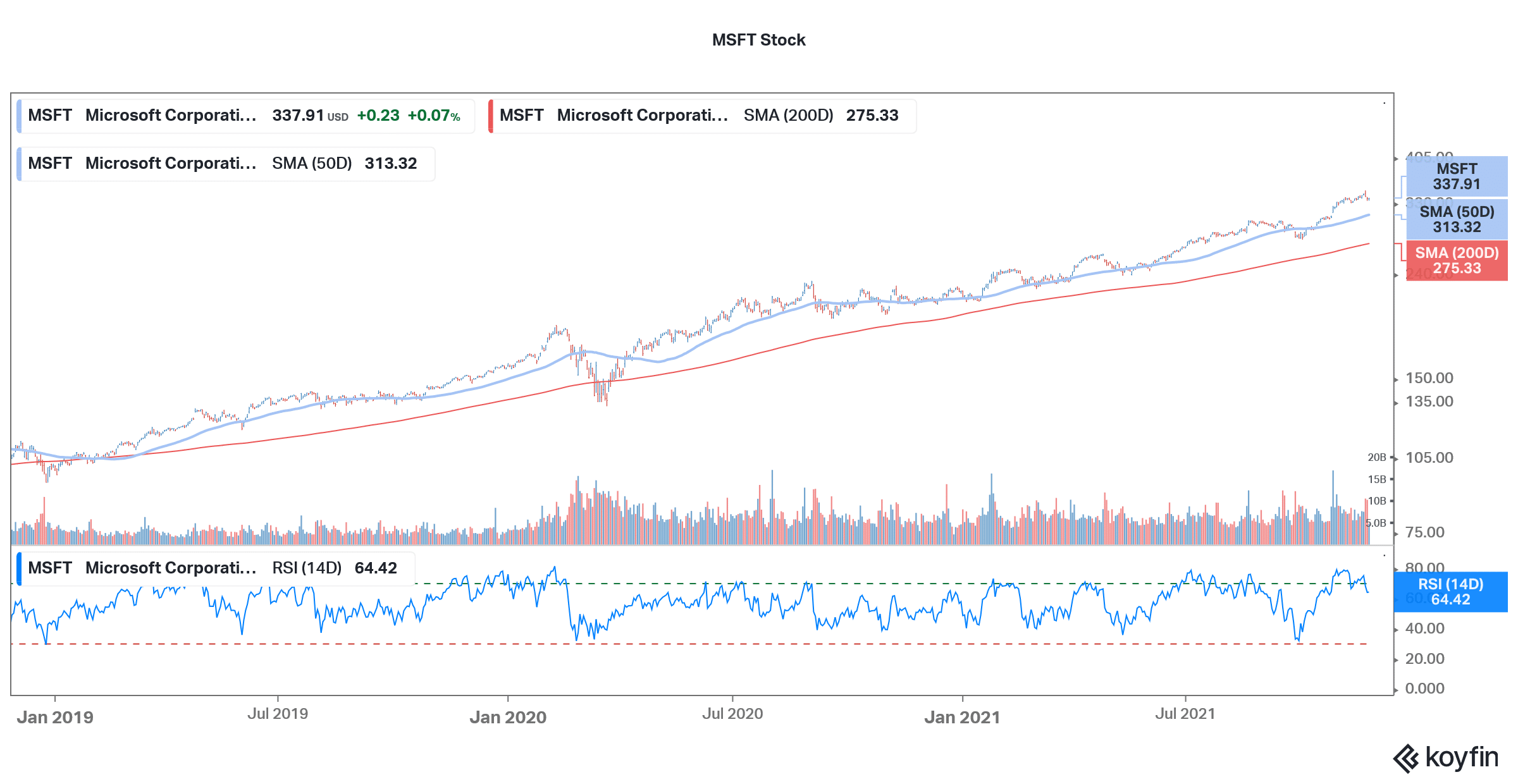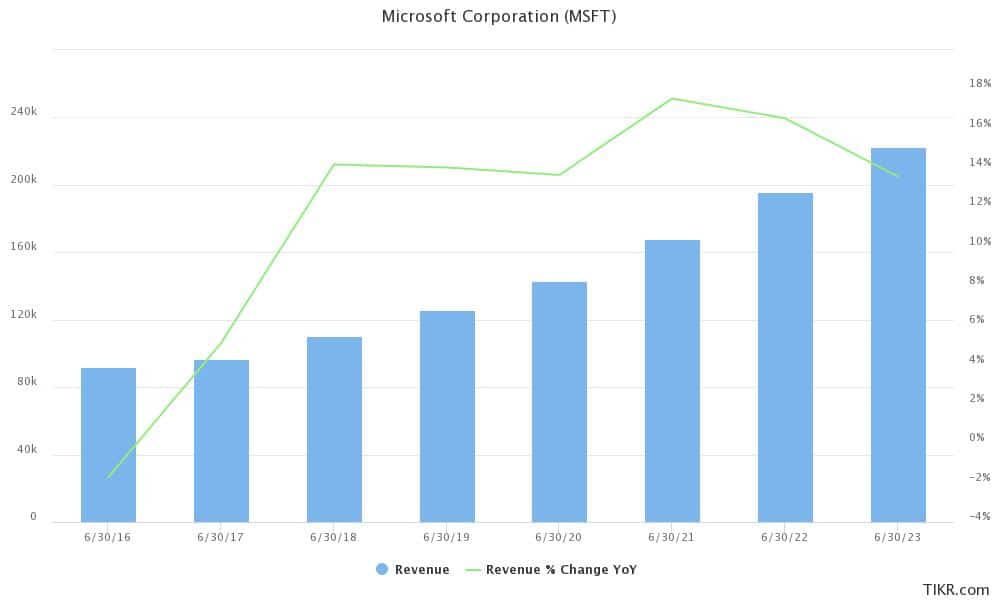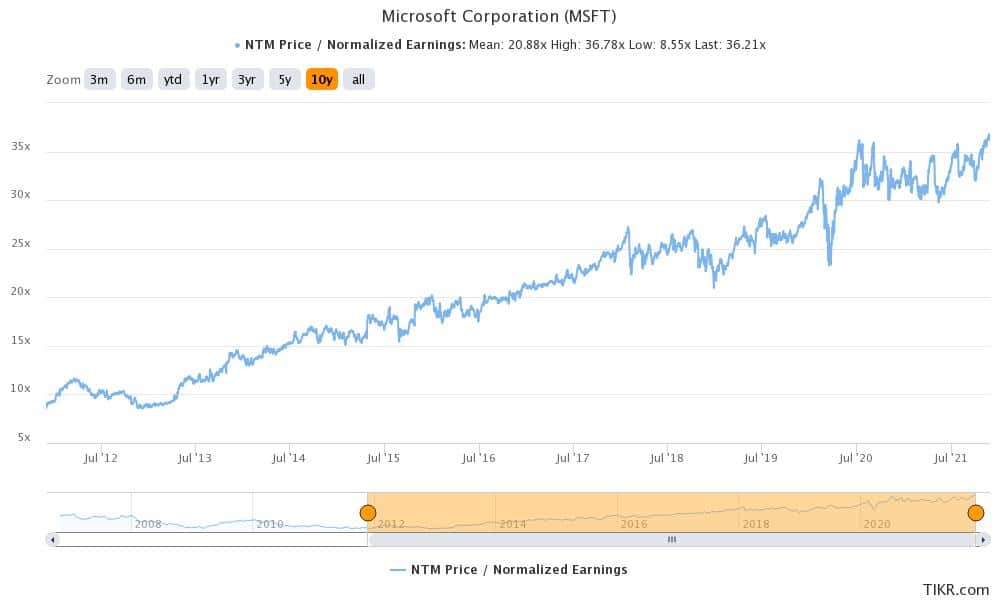Microsoft Stock Price Up 52% in 2021 – Time to Buy MSFT Stock?
Please note that we are not authorised to provide any investment advice. The content on this page is for information purposes only.
Microsoft (MSFT) stock has been strong in 2021 and is up almost 52% in the year. While FAANG names like most of the attention in the Big Tech space, MSFT stock is outperforming FAANG stocks with the exception of Alphabet this year.
Microsoft recently surpassed Apple to become the biggest company by market cap. While Microsoft’s earnings were better than expected, Apple missed topline estimates due to chip shortage. The two companies now run neck-to-neck in the race for the biggest company. What’s the forecast for MSFT stock and is it a good buy despite the massive 2021 outperformance?
Microsoft stock technical analysis

Microsoft stock is looking bullish on the charts. It trades above the 50-day, 100-day, and 200-day SMA (simple moving average). Its 14-day RSI (relative strength index) is 64.4 which is a neutral indicator. The stock has been in an uptrend and has been making new highs. However, its 12,26 MACD (moving average convergence divergence) gives a sell signal.
68% of all retail investor accounts lose money when trading CFDs with this provider.
MSFT stock recent news
Last month, Microsoft released its earnings for the fiscal first quarter of 2022. The company’s revenues increased 22% YoY during the period and reached $45.3 billion. Its operating income increased 27% to $20.2 billion. The strong performance was led by the 36% rise in cloud revenues. The company’s cloud segment generated revenues of $20.7 billion in the quarter.
The company’s Office and Windows suite of products have also been doing well after years of sagging sales. During the quarter, its Productivity and Business Processing segment reported a 22% rise in revenues. The revenues of Office commercial products and cloud increased 18% while Office consumer products and cloud revenues increased 10%. LinkedIn’s revenues increased 42% YoY.
Microsoft announced a new buyback program
The company returned $10.9 billion to stockholders in the quarter in the form of dividends and buybacks. In September, Microsoft unveiled a new repurchase program and intends to buy back up to $60 billion of its shares. While the earnings of US tech companies have increased over the last year, they don’t have ample growth opportunities. In the absence of organic and inorganic growth prospects, companies have been returning cash to shareholders. MSFT’s new share repurchase plan does not have an expiration date and can be terminated at any time.

MSFT stock forecast
The forecast for MSFT stock looks positive. The digital transformation that accelerated due to the COVID-19 pandemic, will only strengthen in the coming years. Microsoft is among the best plays on digital transformation.
Most Wall Street analysts are bullish on Microsoft stock. Of the 38 analysts covering the stock, 34 rate them as a buy or some equivalent while the remaining four analysts rate it as a hold. None of the analyst rates MSFT stock as a sell.
Its median target price of $364 implies a 7.7% upside over the current levels. The stock’s street high target price of $410 is a premium of 21.3% while the street low target price of $293 is a discount of 13%.
Microsoft stock target price
Some of the analysts have been turning incrementally bullish in MSFT stock and have raised its target price. Earlier this month, Wells Fargo initiated coverage on the stock with a buy rating and $400 target price. “Even after having become one of the largest companies on the planet … we still see a bright future ahead for Microsoft, driven by continued growth prospects in huge categories of IT spend … ability to further monetize strong positioning in multiple end markets … and a financial profile that continues to exhibit durable growth and margin expansion,” said Wells Fargo in its note.
In November only, Credit Suisse also raised MSFT’s target price to $400. Fundamental Research also lifted the stock’s target price. Last month, several brokerages including Evercore ISI, Cowen, and Bank of America had raised the stock’s target price after the earnings release.

MSFT stock long-term forecast
The long-term forecast for MSFT stock looks positive. The demand for PCs, which have been sagging for years, has seen a spike over the last year. Also, the pivot towards cloud and AI would support the company’s long-term earnings as well as valuation. Incidentally, over the last few years, Microsoft has transformed its business to focus on high-growth industries which have led to a valuation rerating for the stock.
The company is expected to grow in strong double digits in the near term and analysts are forecasting a 16.5% increase in the current fiscal year’s revenues followed by a 13.6% rise in the next fiscal year’s revenues.
Should you buy Microsoft stock?
Microsoft stock currently trades at an NTM (next-12 months) PE multiple of 36.2x. To put that in perspective, the multiples have averaged 29.8x over the last three years and 27.3x over the last five years. The average multiples for the last ten years are even lower at 20.8x. However, the gradual rise in MSFT’s valuation multiples is reflective of how the company has changed its perception. It hasn’t been an overnight success and gradually the company has placed itself on a high growth trajectory under the leadership of Satya Nadella.
Meanwhile, while there might not be much scope for valuation multiple expansion, MSFT should continue to see a steady rise in earnings which would drive the stock higher. If you are looking to play the digital transformation, MSFT looks among the best bets.






